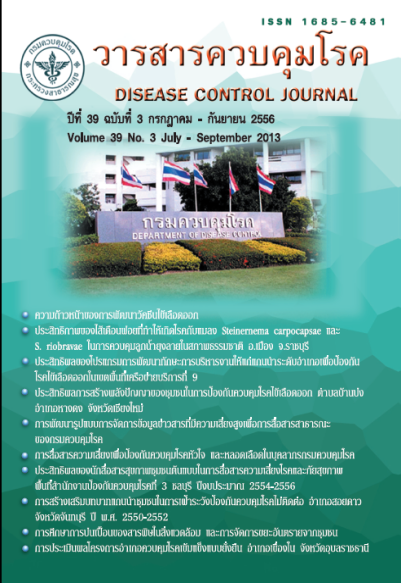Progess of dengue vaccine development
DOI:
https://doi.org/10.14456/dcj.2013.10Keywords:
Dengue vaccineAbstract
Dengue is a disease that is a public health problem in many countries and is becoming more serious. There is no specific treatment; and vector control measures are not effective enough. Therefore, vaccine is the only hope for controlling this disease. Dengue vaccine development has been initiated since 1940 but there is still no usable dengue vaccine available. The main obstacles are the need of vaccine to be tetravalent, the risk of antibody-dependent enhancement and the lack of animal model. Nevertheless, dengue vaccine development has made a great progress in recent decade. Progress of technologies for vaccine development bring out variety of dengue vaccine candidates according to development techniques: live attenuate vaccine, live attenuate recombinant (chimeric) vaccine, purified inactivated virus, recombinant subunits, virus-like particles (VLPs), DNA vaccine and virus-vectored dengue vaccines. Each type of vaccines has both advantages and disadvantages on side effects, immune response, immunity duration and stability of vaccine during storage and transport. Currently, there are 6 tetravalent vaccine candidates that are in clinical phase. The most advanced vaccine currently being studied in phase 3 is "live attenuated chimeric vaccine''. This vaccine is developed from core yellow fever YF-17D vaccine recombinant with 4 serotypes of dengue viruses. The studied results in phase 2b found that the vaccine is safe but it can protect only 3 serotypes (1, 3 and 4). It is expected that the product will be available soon. However, the study results may not be as expected, so the Environment managements to reduce the risk of mosquito breeding sources are still needed.
Downloads
References
2. Durbin AP, Whitehead SS. Dengue vaccine candidates in development. Curr Top Microbiol Immuno l2010; 338: 129-43.
3. Schmitz J, Roehrig J, Barrett A, et al. Next generation dengue vaccines: A review of candidates 7277-88.
4. Luplertlop N. Overview of dengue viruses and their relations. J Trop Med Parasitol. 2008; 31: 102.
5. Simmons M, Teneza-mora N, Putnak R. Advances in the development of vaccines for dengue fever. In editor. Vaccine: Development and
therapy: 2012; 6.
6. Roehrig JT. Current status of dengue vaccine development [Internet]. 2013 [cited 2013 Jul 31]. Available from: http://www.who.int/immuniz
a t i o n / s a g e / m e e t i n g s / 2 0 1 3 / a p r i l /2_Roehrig_Dengue_SAGE_April2013.pdf.
7. Sabchareon A, Wallace D, Sirivichayakul C, Limkittikul K, Chanthavanich P, Suvannadabba, et al. Protective efficacy of the recombinant,
live-attenuated, CYD tetravalent dengue vaccine in Thai school children: A randomised, controlled phase 2b trial. Lancet 2012; 380: 1559-67.
Downloads
Published
How to Cite
Issue
Section
License
Articles published in the Disease Control Journal are considered as academic work, research or analysis of the personal opinion of the authors, not the opinion of the Thailand Department of Disease Control or editorial team. The authors must be responsible for their articles.






